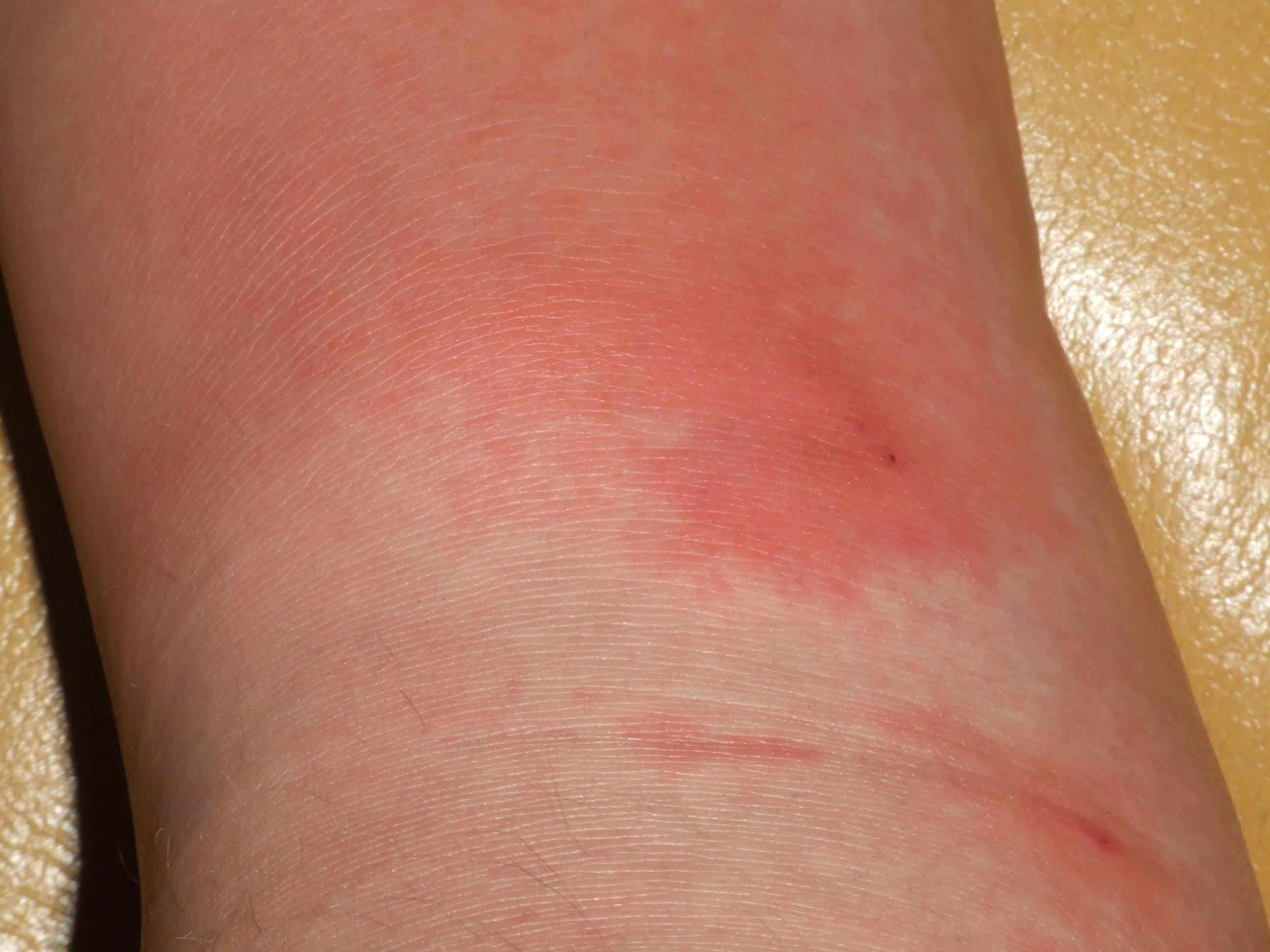Erysipela: Difference between revisions
m (Bot: Automated text replacement (-{{SIB}} + & -{{EJ}} + & -{{EH}} + & -{{Editor Join}} + & -{{Editor Help}} +)) |
m (Robot: Automated text replacement (-{{WikiDoc Cardiology Network Infobox}} +, -<references /> +{{reflist|2}}, -{{reflist}} +{{reflist|2}})) |
||
| Line 66: | Line 66: | ||
==Footnotes== | ==Footnotes== | ||
{{reflist}} | {{reflist|2}} | ||
==External links== | ==External links== | ||
Revision as of 17:11, 4 September 2012
| Erysipelas | |
 | |
|---|---|
| Erysipelas | |
| ICD-10 | A46.0 |
| ICD-9 | 035 |
| DiseasesDB | 4428 |
| MedlinePlus | 000618 |
| eMedicine | derm/129 |
| MeSH | D004886 |
|
WikiDoc Resources for Erysipela |
|
Articles |
|---|
|
Most recent articles on Erysipela |
|
Media |
|
Evidence Based Medicine |
|
Clinical Trials |
|
Ongoing Trials on Erysipela at Clinical Trials.gov Clinical Trials on Erysipela at Google
|
|
Guidelines / Policies / Govt |
|
US National Guidelines Clearinghouse on Erysipela
|
|
Books |
|
News |
|
Commentary |
|
Definitions |
|
Patient Resources / Community |
|
Patient resources on Erysipela Discussion groups on Erysipela Directions to Hospitals Treating Erysipela Risk calculators and risk factors for Erysipela
|
|
Healthcare Provider Resources |
|
Causes & Risk Factors for Erysipela |
|
Continuing Medical Education (CME) |
|
International |
|
|
|
Business |
|
Experimental / Informatics |
Editor-In-Chief: C. Michael Gibson, M.S., M.D. [1]
Erysipelas (Greek ερυσίπελας - red skin) is an acute streptococcus bacterial infection of the dermis, resulting in inflammation and characteristically extending into underlying fat tissue. This disease is also known as Saint Anthony's fire.
Risk factors
This disease is most common among the elderly, infants, and children. People with immune deficiency, diabetes, alcoholism, skin ulceration, fungal infections and impaired lymphatic drainage (e.g., after mastectomy, pelvic surgery, bypass grafting) are also at increased risk.
Signs and symptoms
Patients typically develop symptoms including high fevers, shaking, chills, fatigue, headaches, vomiting, and general illness within 48 hours of the initial infection. The erythematous skin lesion enlarges rapidly and has a sharply demarcated raised edge. It appears as a red, swollen, warm, hardened and painful rash, similar in consistency to an orange peel. More severe infections can result in vesicles, bullae, and petechiae, with possible skin necrosis. Lymph nodes may be swollen, and lymphedema may occur. Occasionally, a red streak extending to the lymph node can be seen.
The infection may occur on any part of the skin including the face, arms, fingers, legs and toes, but it tends to favor the extremities. Fat tissue is most susceptible to infection, and facial areas typically around the eyes, ears, and cheeks. Repeated infection of the extremities can lead to chronic swelling (lymphadenitis).
Etiology
Most cases of erysipelas are due to Streptococcus pyogenes (also known as group A streptococci), although non-group A streptococci can also be the causative agent. Historically, the face was most affected; today the legs are affected most often. [1]
Erysipelas infections can enter the skin through minor trauma, eczema, surgical incisions and ulcers, and often originate from strep bacteria in the subject's own nasal passages.
Diagnosis
This disease is mainly diagnosed by the appearance of the rash and its characteristics. Blood cultures are unreliable for diagnosis of the disease, but may be used to test for sepsis. Erysipelas must be differentiated from herpes zoster, angioedema, contact dermatitis, and diffuse inflammatory carcinoma of the breast.
Erysipelas can be distinguished from cellulitis by its raised advancing edges and sharp borders. Elevation of the antistreptolysin O titre occurs after around 10 days of illness.
Treatment
Depending on the severity, treatment involves either oral or intravenous antibiotics, using penicillins, clindamycin or erythromycin. While illness symptoms resolve in a day or two, the skin may take weeks to return to normal.
Because of the risk of reinfection, prophylactic antibiotics are sometimes used after resolution of the initial condition. However, this approach does not always stop reinfection.[2]
Complications
- Spread of infection to other areas of body through the bloodstream (bacteremia), including septic arthritis and infective endocarditis (heart valves).
- Septic shock.
- Recurrence of infection – Erysipelas can recur in 18-30% of cases even after antibiotic treatment.
- Lymphatic damage
- Necrotizing fasciitis -- AKA "the flesh-eating bug." A potentially-deadly exacerbation of the infection if it spreads to deeper tissue.
Deaths
- Father Solanus Casey, Capuchin monk and 20th Century spiritual figure, 1870-1957, USA[3]
- Charles Lamb
- Princess Amelia, daughter of George III
- Miller Huggins, manager of the New York Yankees from 1918 until his death in 1929
- James A. Bailey
- Anne of Great Britain
- William H. Crawford, Secretary of the Treasury in the administration of President James Monroe.
- John Stuart Mill; political philosopher most famous for his work On Liberty[4]
- Judith of Swabia, daughter of the Holy Roman Emperor Henry III
In animals
Erysipelas is also the name given to an infection in animals caused by the bacterium Erysipelothrix rhusiopathiae. Infection by Erysipelothrix rhusiopathiae in humans is a separate entity known as erysipeloid.
Footnotes
- ↑ See eMedicine link
- ↑ Koster JB, Kullberg BJ, van der Meer JW (2007). "Recurrent erysipelas despite antibiotic prophylaxis: an analysis from case studies". The Netherlands journal of medicine. 65 (3): 89–94. PMID 17387234.
- ↑ Wollenweber, Brother Leo (2002) "Meet Solanus Casey", St. Anthony Messanger Press, Cincinnati, Ohio Page 107 ISBN 1-56955-281-9
- ↑ Capaldi, Nicholas (2004). John Stuart Mill: a biography. Cambridge, UK: Cambridge University Press. p. 356. ISBN 0-521-62024-4.
External links
- Erysipelas Overview Health in Plain English - with pictures
bs:Erizipel cs:Erysipel de:Erysipel eo:Erizipelo hr:Erizipel it:Erisipela lt:Rožė (liga) nl:Erysipelas no:Erysipelas scn:Risibbella sr:Црвени ветар fi:Ruusu (sairaus) sv:Rosfeber